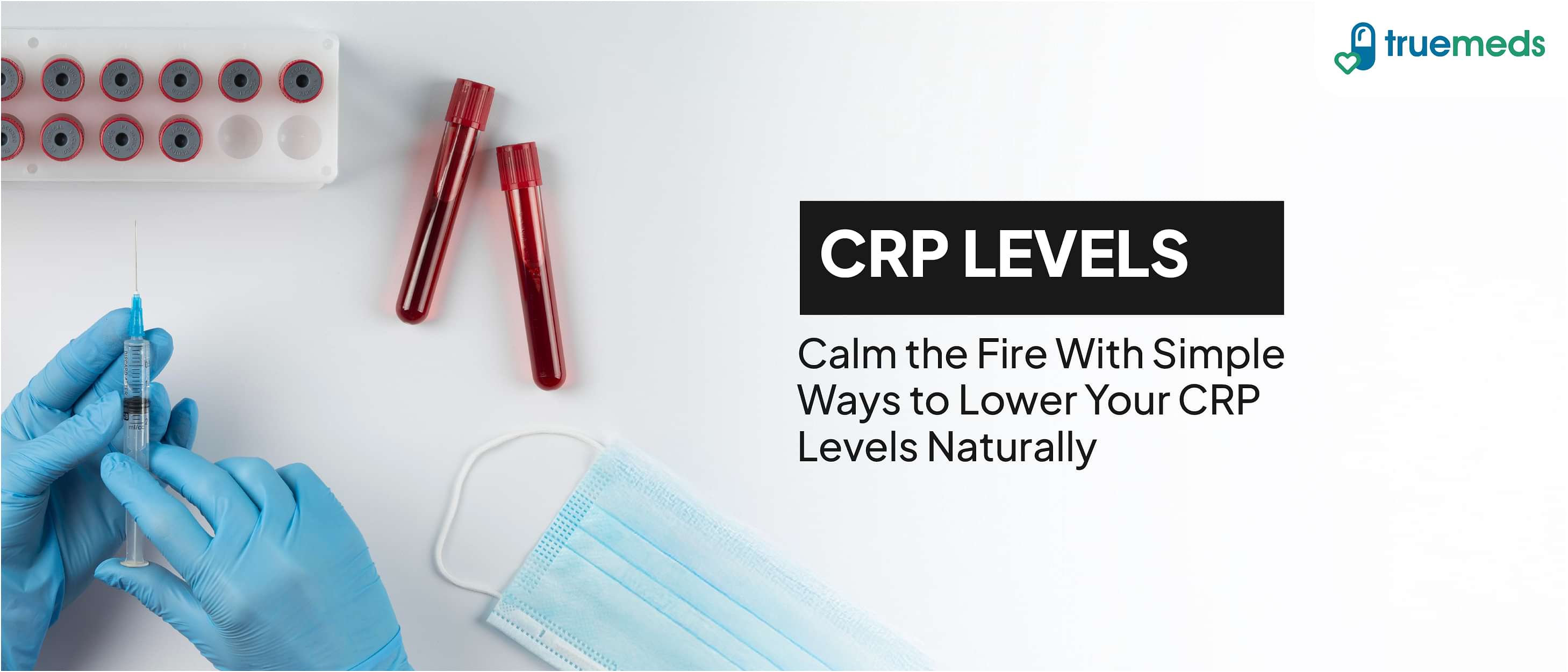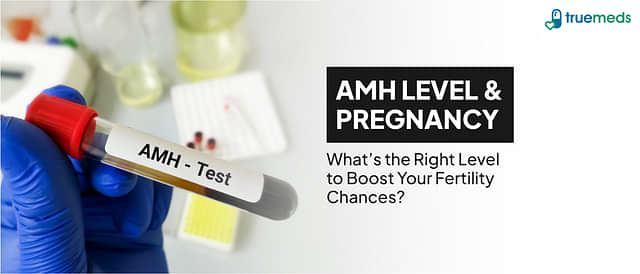How Much CRP Level Is Dangerous? Understanding Risks and Reduction Methods
Last updated on : 07 Nov, 2025
Read time : 9 min
C-reactive protein (CRP) is a marker of inflammation in the body, and elevated levels can be a warning sign. Whether you’re managing a chronic condition or just keeping an eye on your health, understanding your CRP level can help you detect and respond to inflammation early.
In this article, we explore what CRP is, what various levels mean, the health conditions linked to elevated CRP, and evidence-based steps to potentially reduce it.
What is CRP?
CRP, or C-reactive protein, is a protein produced by the liver in response to inflammation in the body [1]. It is an acute-phase reactant, meaning that its levels increase in the blood when there is inflammation, infection, or tissue damage. Doctors use CRP as a biomarker to detect inflammation and monitor treatment [1]. It’s often one of the first signs your immune system is responding to a problem. Knowing your CRP levels can provide valuable insights into your overall health, but the results must always be interpreted by a healthcare professional in the context of your overall clinical picture [2].
Interpreting CRP Levels: From Normal to High Ranges
CRP is a vital marker of inflammation in the body, and its levels can provide valuable insights into your health status. Elevated CRP levels are associated with various health risks, ranging from mild to severe conditions. Let’s explore the commonly used interpretive CRP ranges and their general clinical implications. (Note: Reference ranges can vary slightly between laboratories and tests, such as the standard CRP test versus the high-sensitivity CRP (hs-CRP) test used specifically for cardiovascular risk assessment [3]).
1. Low or Typical Range
A low CRP level is generally considered a sign of minimal active inflammation.
- CRP below 3 mg/L (0.3 mg/dL) is often considered normal in the general population [1].
- Indicates minimal systemic inflammation.
- For cardiovascular risk assessment (using hs-CRP), a level below 1 mg/L is generally classified as low risk [4].
2. Mildly Elevated
Mild elevations in CRP may occur in various non-infectious conditions.
- CRP typically between 3-10 mg/L (0.3-1.0 mg/dL) is considered mildly elevated.
- Can be seen in conditions like pregnancy, diabetes, obesity, smoking, and a sedentary lifestyle [1].
- May also be associated with an intermediate or high risk of cardiovascular disease (when measured by hs-CRP) [4].
3. Moderately Elevated
Moderate elevations in CRP levels suggest more significant inflammatory activity or an underlying health issue.
- CRP generally between 10-100 mg/L (1.0-10.0 mg/dL) is moderately elevated.
- Commonly linked to autoimmune disease flare-ups, certain infections, recent minor surgery, or a heart attack [5].
- Further diagnostic tests are typically needed to pinpoint the exact cause of the inflammation [5].
4. Significantly Elevated
Significantly elevated CRP levels indicate severe inflammation and are often linked to acute, active conditions.
- CRP typically between 100-500 mg/L (10.0-50.0 mg/dL) [1].
- Highly suggestive of acute bacterial infections, major trauma, or extensive tissue damage [1].
- Requires prompt medical attention for diagnosis and targeted treatment.
5. Markedly or Severely Elevated
Markedly elevated CRP levels are rare and strongly indicative of a serious, acute process.
- CRP above 500 mg/L (50.0 mg/dL) is rare and often associated with severe, systemic bacterial infections like sepsis [6].
- This range necessitates immediate hospitalisation and urgent, intensive medical management [6].
What Causes CRP Levels To Rise?
CRP levels can rise in response to a variety of inflammatory conditions, such as:
- Acute infections (Bacterial, viral, or fungal) [1].
- Chronic inflammatory or autoimmune diseases like rheumatoid arthritis and systemic lupus erythematosus (SLE) [1].
- Acute events, including a heart attack (myocardial infarction) or pancreatitis.
- Chronic conditions like uncontrolled diabetes, obesity, and an inactive lifestyle, which are linked to chronic low-grade inflammation [7].
- The production of CRP is triggered by the release of pro-inflammatory messengers, primarily a cytokine called interleukin-6 (IL-6), from immune cells during an inflammatory response [2]. Understanding these underlying factors is essential for identifying and addressing underlying health issues.
How to Test CRP Levels?
Testing your CRP level is a simple process. Here are some key points to keep in mind:
- No special preparation is typically needed for a standard CRP blood test [1].
- A doctor or nurse will take a blood sample from a vein in your arm.
- The test results will indicate the concentration of CRP in your blood, which your doctor will interpret in the context of your overall health, symptoms, and other test results [1].
- CRP tests can sometimes provide early clues about subclinical inflammation, acting as a non-specific indicator of organ stress or heightened risk for certain chronic conditions [8].
Ways to Potentially Reduce CRP Levels
You can effectively work toward lowering your CRP levels by making particular lifestyle and dietary changes that reduce systemic inflammation [9]:
- Adopt an Anti-Inflammatory Diet: Focus on a dietary pattern rich in fruits, vegetables, whole grains, and healthy fats (like the Mediterranean diet). Limit refined carbohydrates, processed meats, and excessive sugar intake, which can promote inflammation [9].
- Increase Physical Activity: Engage in regular, moderate-intensity exercise. Aim for the current public health recommendation of at least 150 minutes per week (e.g., brisk walking) [9]. Maintaining consistency is key to reducing chronic low-grade inflammation.
- Manage Stress: Chronic psychological stress is linked to increased inflammation. Practices such as yoga, Tai Chi, Qigong, or meditation can help reduce stress hormones and potentially improve your CRP profile [10].
- Maintain a Healthy Body Weight: Excess body fat, particularly around the abdomen, is metabolically active and produces inflammatory markers like IL-6. Achieving and maintaining a healthy weight is one of the most effective strategies for lowering consistently elevated CRP [7].
When to See Your Doctor?
It is crucial to consult your doctor if you experience any of the following:
- Test results showing a CRP level persistently above 10 mg/L [5].
- Acute symptoms such as high or persistent fever, severe pain, unexplained weight loss, or swelling.
- Symptoms or flares of a known chronic condition such as heart disease, inflammatory bowel disease, or an autoimmune disorder.
- In children, any significantly raised CRP level accompanying fever or concerning symptoms warrants prompt medical evaluation to rule out a serious infection [11].
Conclusion
CRP is a useful and important marker for tracking inflammation and overall health. Mild increases may reflect general lifestyle factors, but consistently or markedly high CRP levels could point to underlying medical conditions that need thorough attention.
By making smart, sustainable lifestyle changes, such as adopting an anti-inflammatory diet, remaining physically active, and prioritizing stress management, you can often work to reduce inflammation naturally and improve your CRP profile.
If you’re concerned about your CRP level, remember that it is a non-specific marker; do not attempt to self-diagnose or self-treat. Schedule a follow-up appointment with your doctor to understand what the result means in the context of your unique health profile.
Frequently Asked Questions (FAQs)
What happens if your CRP is high?
High CRP levels suggest significant inflammation in the body. This may be caused by an acute issue like an infection or injury, or by an active chronic condition such as arthritis or a heightened risk of heart disease [1], [4].
What is a normal CRP level?
A typical CRP level in the general population is often considered to be below 3 mg/L [1]. For cardiovascular risk assessment (using hs-CRP), a level below 1 mg/L is generally considered low risk [4].
How much CRP level is dangerous in a child?
A raised CRP in children suggests infection or inflammation and needs medical evaluation. A value greater than 10 mg/L may warrant further investigation to determine the cause, and a very high value is highly suspicious for a significant bacterial infection [11].
Which infection causes the highest CRP rise?
Acute, widespread bacterial infections (e.g., severe pneumonia, sepsis) typically cause the most rapid and highest rise in CRP, often pushing levels well above 100 mg/L. Viral infections usually cause less dramatic elevations [1].
How can I lower my CRP naturally?
You can work to lower CRP naturally by adopting an anti-inflammatory diet, exercising regularly, achieving and maintaining a healthy body weight, and prioritising stress management techniques [9].
References
[1] Singh, B., Patel, B. C., & Goyal, A. (2023). C reactive protein (CRP). National Library of Medicine; StatPearls Publishing. https://www.ncbi.nlm.nih.gov/books/NBK441843/
[2] Sproston, N. R., & Ashworth, J. J. (2018). Role of C-Reactive Protein at Sites of Inflammation and Infection. Frontiers in Immunology, 9(754). https://doi.org/10.3389/fimmu.2018.00754
[3] Eckschlager, C., Schwenoha, K., Roth, C., Bogner, B., & Oostingh, G. J. (2019). Comparative analysis of high CRP-levels in human blood using point-of-care and laboratory-based methods. Practical Laboratory Medicine, 17, e00137. https://doi.org/10.1016/j.plabm.2019.e00137
[4] Luan, Y., & Yao, Y. (2018). The Clinical Significance and Potential Role of C-Reactive Protein in Chronic Inflammatory and Neurodegenerative Diseases. Frontiers in Immunology, 9. https://doi.org/10.3389/fimmu.2018.01302
[5] Landry, A., Docherty, P., Ouellette, S., & Cartier, L. J. (2017). Causes and outcomes of markedly elevated C-reactive protein levels. Canadian Family Physician, 63(6), e316–e323. https://www.cfp.ca/content/63/6/e316.short
[6] Young, B., Gleeson, M., & Cripps, A. W. (1991). C-reactive protein: A critical review. Pathology, 23(2), 118–124. https://doi.org/10.3109/00313029109060809
[7] Luan, Y., & Yao, Y. (2018). The Clinical Significance and Potential Role of C-Reactive Protein in Chronic Inflammatory and Neurodegenerative Diseases. Frontiers in Immunology, 9. https://doi.org/10.3389/fimmu.2018.01302
[8] Luan, Y., & Yao, Y. (2018). The Clinical Significance and Potential Role of C-Reactive Protein in Chronic Inflammatory and Neurodegenerative Diseases. Frontiers in Immunology, 9. https://doi.org/10.3389/fimmu.2018.01302
[9] Luan, Y., & Yao, Y. (2018). The Clinical Significance and Potential Role of C-Reactive Protein in Chronic Inflammatory and Neurodegenerative Diseases. Frontiers in Immunology, 9. https://doi.org/10.3389/fimmu.2018.01302
[10] Mouliou, D. S. (2023). C-Reactive Protein: Pathophysiology, Diagnosis, False Test Results and a Novel Diagnostic Algorithm for Clinicians. Diseases, 11(4), 132. https://doi.org/10.3390/diseases11040132
[11] Lemiengre, M. B., Verbakel, J. Y., Colman, R., Van Roy, K., De Burghgraeve, T., Buntinx, F., Aertgeerts, B., De Baets, F., & De Sutter, A. (2018). Point-of-care CRP matters: normal CRP levels reduce immediate antibiotic prescribing for acutely ill children in primary care: a cluster randomized controlled trial. Scandinavian Journal of Primary Health Care, 36(4), 423–436. https://doi.org/10.1080/02813432.2018.1529900
Disclaimer
Our healthcare experts have carefully reviewed and compiled the information presented here to ensure accuracy and trustworthiness. It is important to note that this information serves as a general overview of the topic and is for informational purposes only. It is not intended to diagnose, prevent, or cure any health problem. This page does not establish a doctor-patient relationship, nor does it replace the advice or consultation of a registered medical practitioner. We recommend seeking guidance from your registered medical practitioner for any questions or concerns regarding your medical condition.
Popular Articles
Recommended Articles
Recent Articles
Company
About UsHealth ArticleHealth StoriesHealth LibraryDiseases & Health ConditionsAyurvedaUnderstanding Generic MedicinesAll MedicinesAll BrandsNeed HelpFAQSecuritySubscribe
Registered Office Address
Grievance Officer
Download Truemeds
Contact Us
Our customer representative team is available 7 days a week from 9 am - 9 pm.
v4.10.1
2025 - Truemeds | All rights reserved. Our content is for informational purposes only. See additional information.
Our Payment Partners














































